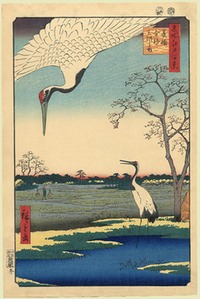Hokusai Umegawa in Sagami province, cranes nearby Mount Fuji

The Red-crowned Crane (Grus japonensis) is a resident bird in Hokkaido but the largest populations of the Japanese crane live in China, Korea and Siberia. In these areas they are migrating birds. Since ancient times the Red-crowned Crane has played an important role in mythology and religion in the Far East. In China the crane is interwoven with religion. In Taoism the Red-crowned Crane is a symbol of longevity and immortality . Cranes often appear in Chinese art carrying the souls of the departed to heaven after death. Immortals are often depicted riding on cranes. (see upper left) The Red-crowned Crane is also a symbol of nobility. The Emperor’s throne in Beijing’s Forbidden City is flanked by statues of cranes. According to Japanese mythology it took a crane a thousand years to fly to the sun. So it is said that a crane lives a thousand years. in Japan the crane symbolizes a long life and happiness. As cranes mate for life, a couple of cranes stands for loyalty and eternal love. Cranes often appear in Japanese art and culture. The (stylized) crane is often used as motif in the design of bridal kimonos, china ware and house decoration (folding screens). In his famous "36 views of Mount Fuji", Hokusai made a fine print of cranes against the background of Mount Fuji. Hiroshige, the other great master of ukiyu-e made many prints showing cranes. For his "100 views of Edo" (Tokyo) he made a daring print showing two cranes against the background of a lonely farmer walking in the rice fields. Koson Ohara belongs to the 20th century generation of Shin Hanga print makers. He was a painter as well as a woodblock printmaker and specialized in realistic flower and bird prints (kacho-e). Koson's prints were very popular in the United States and Europe


